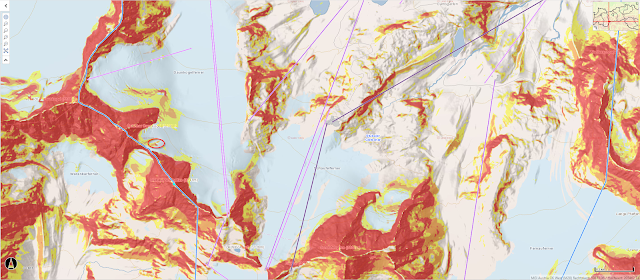First avalanche fatality of this winter season
The course of the accident
Yesterday, 25.01.2023 a person lost his life in an avalanche beneath the Widerschwing on the Carnic Ridge. Four persons were involved in the avalanche, a group of 3 friends and a single person who followed the trio of friends through part of an ascending track. A few seconds before the avalanche triggered the trio heard a settling noise. The avalanche caught one of the trio and the single person in its path. Both persons were totally buried in snow masses. To the orographic right, a secondary avalanche triggered, thereby increasing the depths under which the two victims were buried. Through swift rescue assistance the person belonging to the trio was dug out of his 2.4-metre deep burial spot. The single person had no emergency equipment, and was not found until a probe located him at a depth of about 2 metres about 4 hours after the avalanche. Reanimation was undertaken. He was transported to the Innsbruck Clinic where he died the same day.
.jpg) |
| To the right of the Alpine police, the two points of snow burial are visible, very close to each other. (photo: 26.01.2023) |
.jpg) |
| Investigations by the Alpine Police and Avalanche Warning Service were carried out with the help of a state helicopter. (photo: 26.01.2023) |
Short accident analysis
Together with the Alpine Police we undertook the investigation today. The weak layer significant to the release consisted of faceted crystals which were embedded between two melt-freeze crusts that formed during the Christmas rainfall. This crust sandwich occurs only in a narrow band of altitude at 2200-2400m and demands attentiveness mainly on shady slopes. The previous periods of snowfall amounting to about 50cm were enhancing factors. Equally so was the heavy impact of the NE wind. Snowfall plus wind generated a slab atop the weak layer, which favoured the elongation of the fracture inside the weak layer.
.jpg) |
| Stability tests at the avalanche fracture. The terrain is 45° steep at that point. (photo: 26.01.2023) |
 |
| One profile taken at the avalanche spot. The weak layer occurs between two melt-freeze crusts. The profile was taken orographically to the left of the secondary avalanche at 2350m. The steepness gradient was 33° there, the slope was west-facing. Additional profiles can be found at lawis.at (profile from 26.01.2023) |
In most parts of Tirol: moderate avalanche danger
Following an extended period of considerable avalanche danger, moderate danger currently prevails above 2200m in most parts of Tirol, below that altitude danger is low. The avalanche problems underlying the danger abide: a snowdrift problem and a persistent weak layer. The snowdrift problem requires attentiveness particularly in steep, shady ridgeline terrain.
.jpg) |
| Small slab near a ridgeline in northern Zillertal Alps (photo: 22.01.2023) |
The persistent weak layer is distributed in diffuse ways. Avalanche prone locations are currently not very widespread. In steep terrain which until now is little tracked, a narrow band of altitude at 2200-2400m on shady slopes often evidences this problem. On west-facing and east-facing slopes we find problematic zones mostly above 2500m; even above 2300m particularly on west-facing slopes near ridgelines which are wind-loaded. Steep south-facing slopes have the problem above 2800m.
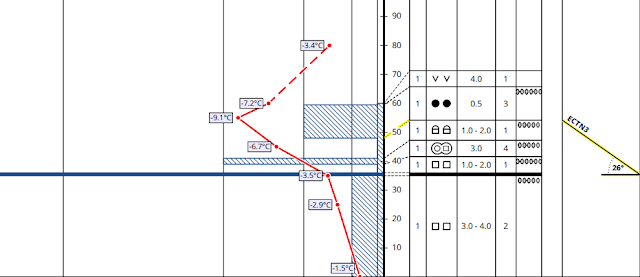 |
| Snow profile, west, 2340m, 26° in the Glockturm Massif. There are numerous potential weak layers. Frequently there is no pronounced slab on top of it. (profile from 26.01.2023) |
.jpg) |
| Slab avalanche on a south-facng slope at about 2900m near Schöntalspitze in Sellrain. The avalanche triggered on 25 January when a person was ascending. (photo: 26.01.2023) |
Powder snow and still too little snow for this juncture of the season
The last two rounds of precipitation brought us some snow, but for this point in the season there is still too little snow on the ground.
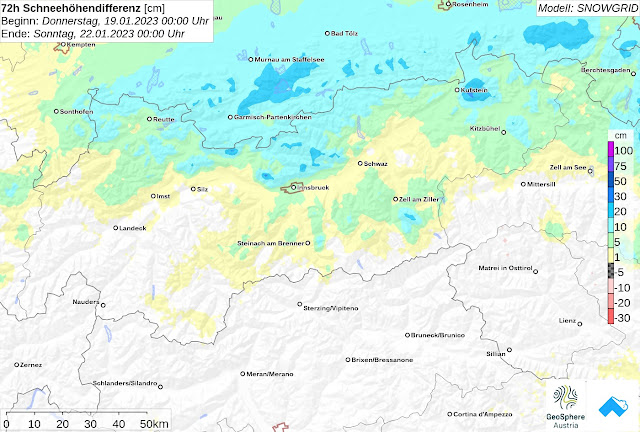 |
| Snowfall on 19-21 January, particularly in the northern regions |
 |
| From 21-24 January, southern regions received snowfall. |
.jpg) |
| In bowls and with a little luck, a descent without hitting rocks is possible. Above view is typical of many regions in Tirol. (photo: 26.01.2023) |
.jpg) |
| Last week enjoyed good powder and less rock contact in some regions. Eastern Tux Alps. (photo: 22.01.2023) |
.jpg) |
| Where are conditions most wintery? Currently in southern East Tirol. (photo: 24.01.2023) |
Super-light, fluffy snow and surface hoar
Due to the low temperatures and the NE air current, the snow fell as super-light, fluffy so-called “wild” snow wherever there was no wind. In extremely steep, sunny terrain, a sequence of loose-snow avalanches triggered in its wake. In the interim, wide expanses of surface hoar have formed in a certain band of altitude, particularly pronounced near the ceiling of high fogbanks.
.jpg) |
| Surface hoar in the eastern Tux Alps (photo: 24.01.2023) |
.jpg) |
| Fog over Inn Valley. This helps to form surface hoar during nights with clear skies. (photo: 26.01.2023) |
Outlook
The really tenacious fog in the northern regions (often extending up to 2000 m) is a major determinant of current weather. It’s cold, winds are frequently strong. Starting on Monday, 30 January, the weather will undergo a radical change. A W/NW air current will bring us wintery and stormy conditions.
_bearbeitet.png)
.jpg)
_bearbeitet_1.jpg)


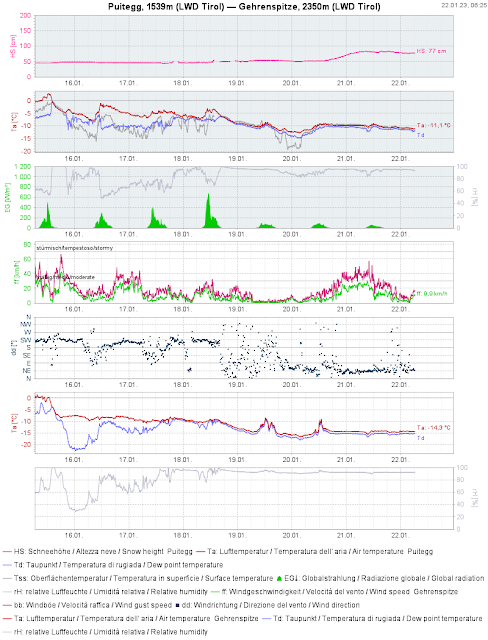

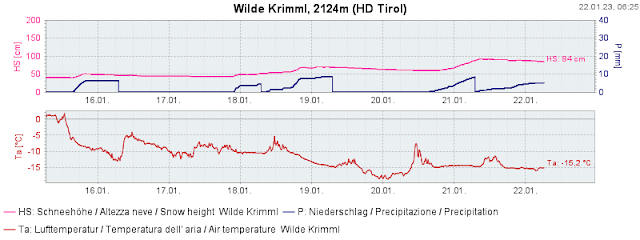
.jpg)
.jpg)
.jpg)
.jpg)
.jpg)
.jpg)
.jpg)
.jpg)

_bearbeitet.jpg)
_bearbeitet.jpg)
_bearbeitet.jpg)
_bearbeitet.jpg)
.jpg)
.jpg)

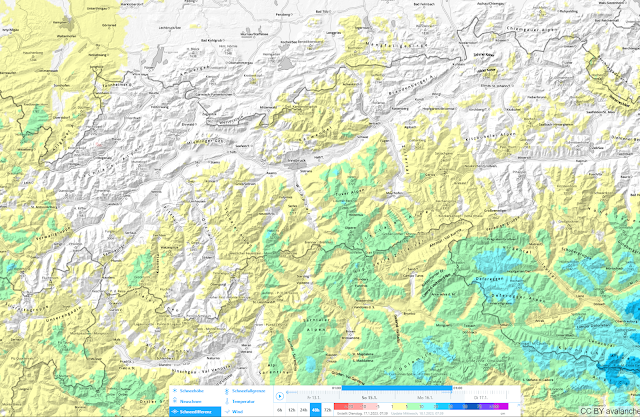

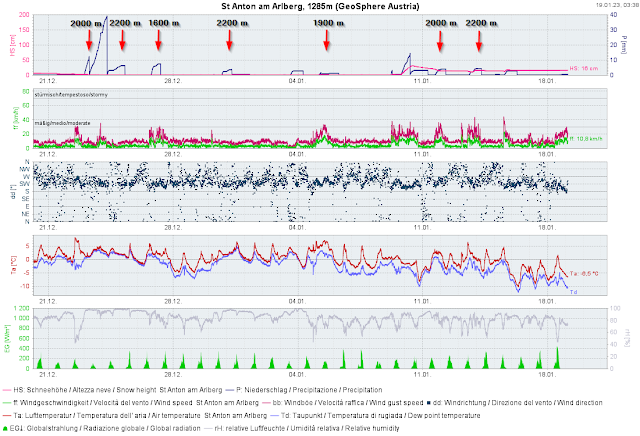

.jpg)
.jpg)
.jpg)
.jpg)
.jpg)
.jpg)
.jpg)


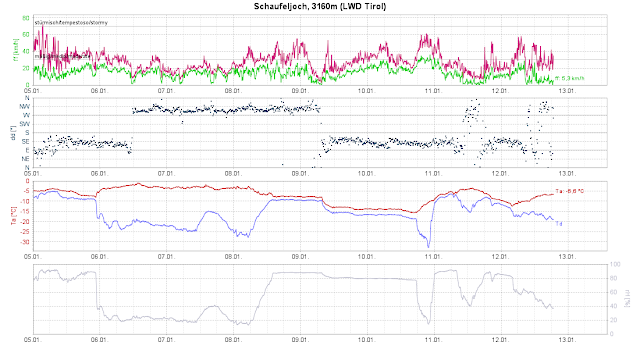
.jpg)
.jpg)
.jpg)
_bearbeitet.jpg)
_bearbeitet_2.png)

